Marie Earle
In 1909, the Marie Earle Institut Anglais de Beauté was established at 279 Rue Saint-Honoré, Paris. The French trade magazine, ‘La Parfumerie Moderne’ (1911), writes that the name of the company was trademarked by a Madame Bernard, née Marie Bastable, so Marie Earle was created as a business name and the Mrs. and Miss Earle who ran the business were using aliases. However, a little digging reveals that these were not the only false names.
The Madame Bernard (née Marie Bastable) who owned the Marie Earle tradename was actually born Janet Juanita Bastable [c.1852-1923] in Kanturk, Cork, Ireland. Her mother’s first name was Margaretta which suggests a Spanish ancestry on her side of the family and this may be why her daughter preferred Juanita over Jane.
In 1874, Juanita moved from Ireland to France where, unmarried, she gave birth to a daughter – also named Juanita [1875-1937]. In 1877, in an attempt to give herself and her daughter a degree of legitimacy, the older Juanita was convicted for attempting to insert a false entry into the Le Havre marriage register for a union between herself and a Comte de Bernard (Le Figaro, 26 April 1877, No. 116, p. 2). Despite failing to have this ‘marriage’ recorded, Juanita clung to the Bernard surname, occasionally calling herself the Comtesse de Bernard, and referred to her daughter as Juanita de Bernard rather than Juanita Bastable. Further name changes were to follow.
In 1881, mother and daughter were to be found in Cookham, Berkshire, England where Juanita, the mother, married Captain Robert Leslie Campbell [1843-1912] and became Mrs. Juanita Campbell. In 1892, the marriage ended in divorce with Juanita cited as having an adulterous relationship with one Joseph Ebbsmith [1849-1899]. Three years later, in 1895, her daughter married the same Joseph Ebbsmith, a man more than twice her age, thereby becoming Juanita Ebbsmith. The marriage was short lived as Ebbsmith died in Spain a few years later.
The relationship between the two Juanitas and Joseph Ebbsmith is not necessarily a case of a man marrying his lover’s daughter. Though cited in the divorce case, Ebbsmith may have taken on the role of ‘adulterer’ to give the older Juanita grounds for divorce and then entered into a marriage of convenience with the younger Juanita to secure her name, her ‘de Bernard’ surname having no status in law.
Whatever the situation, divorce and death meant that both women were unmarried in 1900 which is perhaps why they went into the beauty business. Two of their close relatives were doctors and it may have been through one of them that the women became ‘medical electricians’. Like many other women of their time their entrance into the beauty business was through electrolysis. They appear to have started in Bold Street, Liverpool in 1901 but mother and daughter were also operating at 30 King Street, Manchester by 1903.

Above: 1904 Advertorial for Mrs. and Miss Earle operating in Manchester.
In addition to their tortuous past, there may have been another reason why the two woman decided to work under an assumed name. The beauty trade was then widely considered a dubious business and as other members of the Bastable family were doctors and solicitors and their reputations had to be considered. Why Earle was chosen is unknown but perhaps it was a feminisation of Earl, the English equivalent of Comte (Count), making it an echo of Juanita’s previous attempt to be a Comtessa (Countess).
Some records of the period list the two women as M. Earle and N. Earle. The M is probably for Marie (the mother), the name selected to suggest that she had come from Europe. The N may be for Nita (short for Juanita) the daughter. This was short lived and the pair soon became Mrs. Marie Earle and Miss Marie Earle.
Cosmetics
By 1904, in addition to beauty treatments, the two women were selling some Earle branded skin-care cosmetics including Earle’s Skin Food, Earle’s Antiseptic Bleach and Earle’s Skin Tonic.
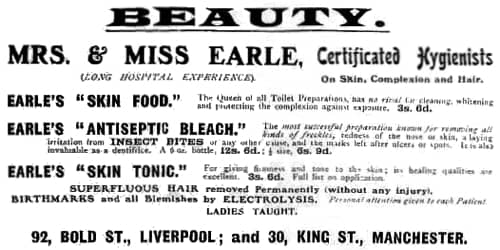
Above: 1904 Mrs. and Miss Earle, Certificated Hygienists.
In a 1926 interview, published in ‘The Evening News’ in Harrisburg, Pennsylvania, Miss Marie Earle remarked that the formulas for her cosmetics had come from her Uncle Herbert Bastable, a Trinity College, Dublin trained, skin specialist with offices in Harley Street, London. This refers to her uncle Daniel Herbert Bastable [1842-1908]. He was trained at Trinity and did work in London but I have no evidence that he was in Harley Street or practiced as a dermatologist.
At some stage, mother and daughter went into partnership with an E. M. Adams but this was gazetted as dissolved in 1910. By then, Mrs. and Miss Earle had opened the Institut Anglais de Beauté in Paris. However, they did not abandon their operations in Britain and continued to sell their cosmetics and other products there through agents.
Electrical treatments
Electrolysis to remove superfluous hair, port-wine stains and other birthmarks, enlarged capillaries and assorted skin blemishes were an important source of income in the Liverpool and Manchester salons and this continued to be the case in Paris.
Marie Earle’s methods are the most advanced scientific and rational on all matters regarding the preservation and enhancement of physical beauty. She has perfected a system of Electrolysis for the permanent removal of superflous [sic] hair, birthmarks, scars, moles, redness of the nose and all blemishes of the skin. After ten years practical experience and a long (London) hospital training she is in a position to guarantee absolute satisfaction as shown by countless testimonials.
(Earle, n.d., p. 1)
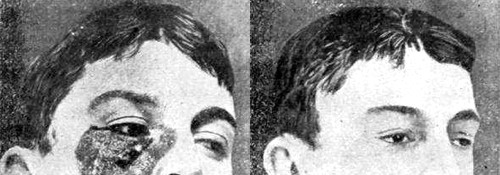
Marie Earle. Before and after photographs of an electrolysis treatment for a port-wine stain.
See also: Electrolysis
Marie Earle also used vibro massage to treat wrinkles and applied galvanic currents to revitalise tired eyes and strengthen facial muscles.
[E]lectric and vibro treatment is unsurpassed for giving firmness to relaxed muscles and tissue, natural freshness can be imparted to the complexion by it in a manner hitherto unknown, no matter how sallow, discoloured, or neglected the skin may be.
(Earle, n.d., p. 1)
Skin-care
The Paris salon offered its clients a wide range of beauty preparations and treatments. Some, such as Earle’s Celebrated Skin Tonic retained their previous Earle branding for a while but most were given French names or marketed as Marie Earle.
Like other Beauty Culturists of her time, Marie Earle suggested that frequent bathing, nourishing food, positive thoughts, and exercise would all help ward off the problems generated by city life and the sedentary lifestyle it created.
See also: Mrs. Pomeroy and Cyclax
Keeping the skin free from ‘impurities’ and other secretions that might block the pores of the skin was considered very important, and frequent bathing using one or more of the bath preparations provided by Marie Earle was recommended. Bathing products sold by Marie earle included bath salts and soaps, as well as an after bath lotion and a toilet powder. Advice from Marie Earle regarding soap was mixed. It was considered too harsh for delicate skins – a caution that was later extended to all skin types – unless it was one of her own.
Once the skin was clean, a range of therapies could then be used to deal with specific skin problems such as dry skin or wrinkles. Like other beauty establishments of the time, these treatments relied on combining skin creams with physical manipulations like massage and strapping.
Wrinkles and dry skin
Marie Earle considered that wrinkles were the result of ‘skin thinning’ and ‘lax muscles’ so recommended using skin foods and muscle oils combined with massage. These would build up the underlying tissue and strengthen the muscles of the face and throat. Many of her preparations were given the title ‘Perfection’ and included: Crème Perfection, a general face cream; Crème Perfection de Jouvance Antirides, (later called Crème Perfection Antirides) for use around the eyes; Crème Baume, a night cream; and Lait Amandes (Almond Milk) which was also useful for dry and damaged skin; and Huile de Jouvance, later Huile Perfection, a muscle oil that also had astringent properties.
Perfection Cream Antiride: “an absolutely necessary preparation for the daily, thorough cleansing of the face, taking the place of soap and water, which are so injurious to an exposed surface. It keeps the skin soft and supple and preserves its lustre.”
Huile de Jouvance: “develops the tissues; a wonderful stimulant composed of fortifying plants, very toning, closes the pores. For use with wrinkle cream, to strengthen the flesh, the muscles of the face and throat.”
See also: Skin Foods and Massage, Wrinkles and Double Chins
Skin tonics
Although Marie Earle advised against ‘violent astringents’ which she considered harmful, she nevertheless used them to firm up the tissues of the face. The astringent was sprayed on clean skin using a small atomiser or a Lucas-Championnière Pulvériser. It was particularly recommended for oily skins as it helped to ‘close the pores’.
Earle’s Celebrated Skin Tonic: “Its bracing and healing qualities are unequalled. A truly refreshing preparation for giving firmness to the skin, distilled from herbs and flowers.”
See also: Skin Tonics, Astringents and Toners and Vaporisers
Skin blemishes
The Elixir of Youth, later known as Elixir Marie Earle, was used to treat acne and other skin blemishes. It was said to preserve and restore natural beauty so powerfully that ‘no woman need ever look old’. It contained ‘liquid oxygen’ (hydrogen peroxide) which ‘destroyed microbes, closed the pores and rendered the skin smooth and supple’. However, hydrogen peroxide is chemically unstable and would have dissipated fairly quickly in the jar, particularly if the lid was not screwed on tight.
Elixir Marie Earle: “has been proved by thousands of women to make the skin proof against all vicissitudes of weather or climate, it is essential to those who wish that their skin should be clear, soft, smooth, and free from sallowness, discolouration of any kind, sun burn and freckles, free also from the blotches of acne and the disfiguring blemishes, attendant on it, for which the Elixir is an absolute cure.”
Cucumber creams were a common treatment for freckles and suntanned skin and Marie Earle also had one in her range (Emulsion de Concombres Perfection) to help keep the face and hands white.
Emulsion de Concombres Perfection: “Cooling and whitening, aids absorption and can be applied on top of the crème antirides.”
See also: Arsenic-Eaters and Cucumber Creams
Eyes
Marie Earle freshened the eyes by combining galvanic treatments with cold and lukewarm compresses, an hour-long procedure she described as a ‘new English discovery’ that lasted for weeks and was better than ‘the old practice of steaming and massage’. Perfection Ointment (Onguent Perfection) was used to promote the growth of eyebrows and eyelashes, and women suffering from red eyes – as for example after motoring – could use a Marie Earle Eye Tonic (Tonique pour les yeux) or Eye Drops (Les Gouttes merveilleuses) to help clear them.
Breasts
Marie Earle had both ‘flesh building’ and ‘flesh reducing’ creams in her product line. The fattening cream (Crème de Moelle) could be used to build up the chest, while the Lotion Réductrice could reduce excess fat on the rest of the body where slimming was needed.
Crème de Moelle: “a rich fattening cream to develop the contours of the neck and bust. a remarkable flesh builder. It transforms a thin scrawny neck into one that is plump and white and youthful. Pat it on the skin after cleansing. to quicken its effectiveness, leave some of the Creme on the skin overnight.”
Lotion Réductrice: “An excellent remedy for double chins and surplus tissue development in all parts of the body. Massage in morning and evening.”
Masks, straps, bands and belts
Women who could not come to the Marie Earle salon for a facial treatment could purchase one of Marie Earle’s ‘Perfection’ face straps. These appear to be have been made from rubber and included a Perfection Face Mask, Perfection Eye Band and Perfection Chin & Throat Band.

Above: Marie Earle eye, face and chin straps.
A Perfection Belt – which acted like a girdle rather than a weight reducing device – was also available for women who wished to reduce the size of their waist.
[A]bsolutely essential to every woman who wishes to have a figure moulded into such graceful proportions that she can appear to the utmost advantage in the clinging and elegant gowns of the day, they are specially made for each person, and are so formed as to reduce the size many inches without in any way causing inconvenience.
(Earle, n.d., p. 1)
Make-up
Marie Earle considered that a painted woman was an ‘abomination’ and an ‘affront to good taste’ but nevertheless considered that a judicious use of ‘cosmétiques’ was ‘harmless and permissible’. Products in her range included: Émail 77, a liquid powder/enamel; Blanc Gras, a powder cream in White and Rachel shades; Perfection Poudre de Riz, a loose face powder in White, Cream, Rachel and Flesh shades; Poudre Feuilles de Roses, powder leaves in three shades; Perfection Feuilles de Roses pour les Joues, rouge leaves in Soft Pink for blondes, Red Carnation for brunettes and Dark Red shades; Perfection Feuilles de Roses, a liquid rouge; Perfection Éclat des Lèvres, a coloured lip balm; Ombre des Paupières, a bluish-gray powdered eyeshadow; and Crayons, eyebrow sticks in Black, Brown, Auburn, Blonde and Blue shades.
Earle’s Cream Niege: “Composed of perfectly harmless ingredients. It obviates in one application brownness and redness of the neck and arms. It imparts a soft, natural whiteness to the skin; invaluable for evening use, and quite imperceptible.”
Blanc Gras: “a finishing creme to be used before powdering. Protects the skin and gives it a soft white appearance.” Shades: Rachel and White.
Émail 77: “an exquisite liquid powder made of the finest imported French ingredients, delicately perfumed. Unrivalled as a beautifier for evening use, but also very effective and becoming in daytime: hides all blemishes; looks perfectly natural on the skin. Absolutely prevents sunburn and freckles; waterproof lasting, does not rub off.”
Poudre de Riz: “The finest French poudre, in three shades, delicately perfumed, will not clog the pores.”
Expansion
Soon after the Institut Anglais de Beauté opened in Paris, Marie Earle advertisements began to appear in New York newspapers offering electrolysis and other beauty treatments to American women visiting Paris. By 1912, Marie Earle had established an American branch at 30 East 57th Street, New York but a salon does not appear to have opened there until 1918. By 1922, this had moved to 600 Madison Avenue.
Not so long ago it was necessary to go to Paris to consult Marie Earle. And many women to whom money meant little and beauty much went to Paris for the privilege. Opinions might differ about the several great couturiers, but the beau monde was agreed upon the supremacy of one specialist. If one desired youth and loveliness, the order to one’s chauffeur was The Salon de Marie Earle. Several great American shops at the request of various women of society’s inner circle installed Marie Earle’s Preparations.
Then Marie Earle herself came to New York, upon the invitation of one of her clients and remained to establish a Salon. At first, she was here for only a brief season annually, now her personal services are available to American women throughout most of the year.(Marie Earle advertisement, 1922)
Both mother and daughter took up residence in New York during this time. When she was not criss-crossing the Atlantic, Juanita Ebbsmith resided at 56, East 56th Street. Her mother was living at 571 Park Avenue when she died in 1923.
1920s
In 1922, Marie Earle incorporated in the United States with Juanita Ebbsmith as its president. By this time the company had opened a second American salon at 1635 Connecticut Avenue, Washington and the Paris salon had relocated to 23 Rue Pasquier. In 1926, the New York salon moved to larger quarters at 659 Fifth Avenue before going across the road to 660 Fifth Avenue in 1927.
In the United States, Marie Earle was heavily promoted as French. Most of its products had been around before the Great War and had kept their French names. Some new lines were introduced, such as Eau Mystérieuse. Its name, and the fact that it started out as a clear liquid but dried to a fine, white powder on the skin, suggests that it was made with a water-soluble analgesic called phenazone.
Eau Mystérieuse: “a transparent liquid which immediately imparts natural whiteness and bloom to the face, neck, and arms, which does not wear off. Apply without rubbing and allow to dry for about five minutes, then wipe the skin firmly with a piece of muslin. Invaluable for greasy skins.”
See also: Liquid Face Powders
Skin types
Marie Earle promoted herself as a ‘specialist in faces’. By the 1920s, washing the face with soap and water was actively discouraged because it dried the skin and promoted wrinkles. Instead, the skin was to be cleansed with Crème Antirides (Essential Cream) which was adveritsed as nourishing as well as cleansing. Emulsion de Conconbres (Cucumber Emulsion) could be applied over the Essential Cream to make the Essential Cream ‘twice as effective’. Both creams were applied with gentle finger strokes – to avoid stretching the skin – and any reference to the previous use of vibro massage disappeared.
Essential Cream and Cucumber Emulsion were used on all skins but Marie Earle recommended that a different skin tonic/astringent be used depending on skin type. Dry skins were to use Eau Antirides (Soothing Freshening Lotion); normal skins, Lait D’Amandes (Almond Astringent); and oily skins, Tonique Pour la Peau (Strong Astringent). As before, these were all applied with an atomiser.
Coty
In 1928, Marie Earle was acquired by Coty, perhaps following the path laid down by Bourjois with its Barbara Gould subsidiary. Juanita Ebbsmith would later retire and return to live in Europe. She died in 1935 at the Hotel Cosmopolitain, Cannes.
See also: Barbara Gould
Coty refurbished the line repackaged it in a jet black, white, and jade colour scheme and added new cosmetics along with a more extensive range of accessories. In 1929, Coty also moved the Paris salon to the more fashionable address of 15 Rue de la Paix. By 1931, a salon was also opened at Central Club, 24 Rue d’Antibes, Cannes.
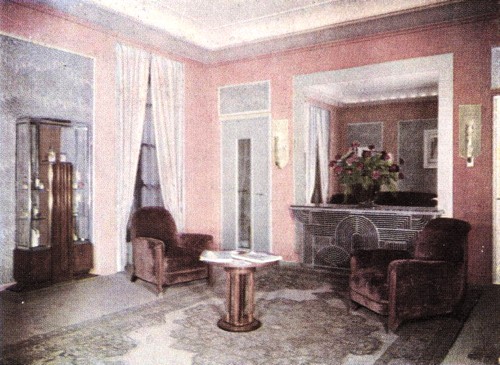
Above: 1930 Reception room at 15 Rue de la Paix, Paris. The salon was decorated by Alavoine & Co., Paris with lacquer work done by Jean Duncan.
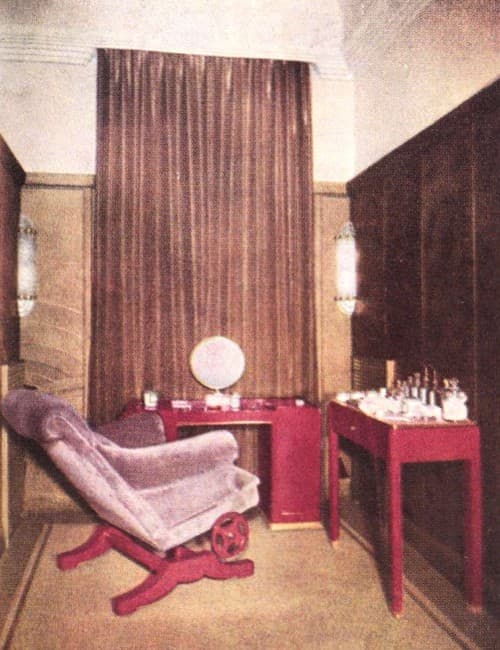
Above: 1930 Treatment room at 15 Rue de la Paix, Paris. There were six treatment rooms in the Paris salon.
Coty also used Marie Earle to distribute Rallet, a perfume line Coty had acquired in 1926. Rallet perfumes were sold through Marie Earle salons and some Rallet lines were specifically developed for Marie Earle, e.g., Rallet No. 1.
1930s
Marie Earle was not immune to the problems caused by the Great Depression of the 1930s and, like many American cosmetic companies of the time,it introduced smaller-sized preparations in 1933 and then modernised its product packaging once more in 1934.
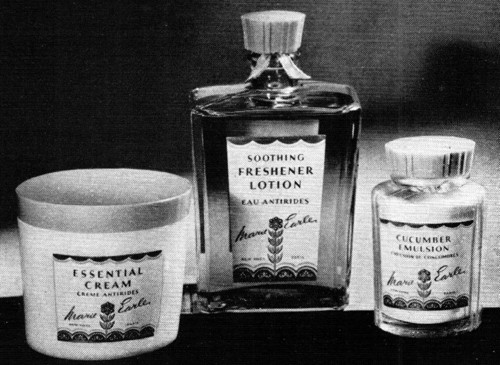
Above: 1934 Marie Earle Essential Cream, Soothing Freshener Lotion and Cucumber Emulsion in new packaging. The English names are now more prominent than the French and a red rose logo has been added.
In 1932, Coty also moved the New York salon to 714 Fifth Avenue, decorating it in the Louis XVI style.

Above: 1932 Reception room at 714 Fifth Avenue, New York with mauve carpeting and rose draperies. The salon was managed by Miss Isabelle M. Whall.
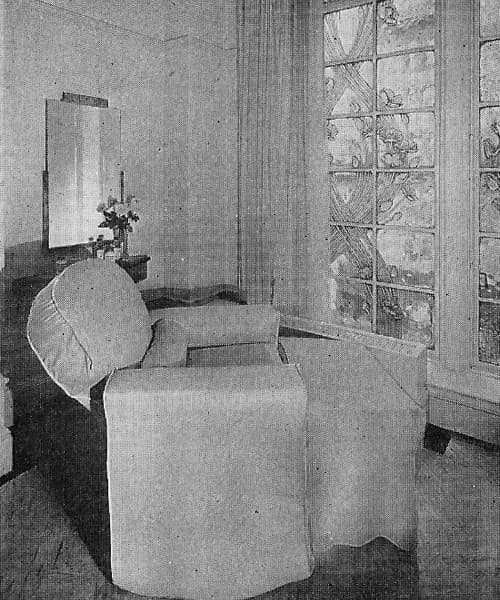
Above: 1932 Treatment room at 714 Fifth Avenue, New York. There were five treatment rooms in the salon each decorated in soft pastel peach.
Skin-care
The Marie Earle skin-care range did not change much during the 1930s. Cleansing was still done with Essential Cream, which continued to be described as being two-propose as it cleansed and nourished. This was followed by Cucumber Emulsion, which nourished and acted as a mild skin whitener, before a toner was sprayed on. As before, the toner was selected by skin type: Soothing Freshener Lotion (Eau Antirides) for Dry skin, Almond Astringent (Lait d’Amandes) for average skin, and Strong Astringent (Tonique pour la Peau) for oily skin. Day and night treatments for each skin type were also included.
Other products in the 1930s range included: Liquid Bleach, to improve the colour, texture and smoothness of the skin and remove freckles; Stimulating Oil, an astringent applied over Essential Cream to improve skin tone and firm sagging muscles; Acne Lotion, used on the face or body for acne and over-active oil glands; Wrinkle Jelly Glaze, a face mask applied before sleeping which tightened on drying; Special Nourishing Oil, spread over the body after a bath to guard against dry skin; Special Nourishing Oil, used with Cucumber Emulsion to develop tissue in the face, neck and bust; Reducing Cream for slimming the fatty tissue of the face, neck, shoulders, back or bust; Marie Earle Hand Lotion; Eye Cream; Eye Wash; Eye drops; and Eyelash Grower. Many of these products had been in the Marie Earle range for decades.
Some new skin-care products were added including Nurimor (1934), a dry skin cream, and Astringent Throat Cream (1935), a throat contouring cream.
Nurimor: This very rich new Cream gives a softening suppling effect—lessening the depth of lines and wrinkles, greatly improving the skin tone. The rapidity and completeness of its absorption by the skin approach a degree hitherto never achieved.
Skin stroking
Coty continued to promote the Marie Earle skin-stroking technique – rather than patting or strenuous rubbing and slapping – as the way to achieve smooth, unlined skin.
As in everything else you undertake in life, it’s not merely what you do but the spirit you put into your task which determines the measure of your success insofar as your home treatment is concerned. Just to apply your creams and lotions faithfully each night is not sufficient, when circulation is sluggish and the nerves of the face and neck are tense. Sluggish circulation must be stimulated—tense nerves, relaxed, through Marie Earle’s scientific stroking movements evolved to correct specific skin defects. Ten minutes a day devoted to the stroking movements your skin requires—and you will find youthful circulation stimulated, nerves perfectly soothed, so that the skin and deeper tissues absorb creams and lotions properly, Resultfully! Drooping muscles, puffiness, deep lines. wrinkles — these and other unwelcome “guests” — are speeded on their way by Marie Earle’s scientific stoking exercises.
(Marie Earle, 1933, p. 19)
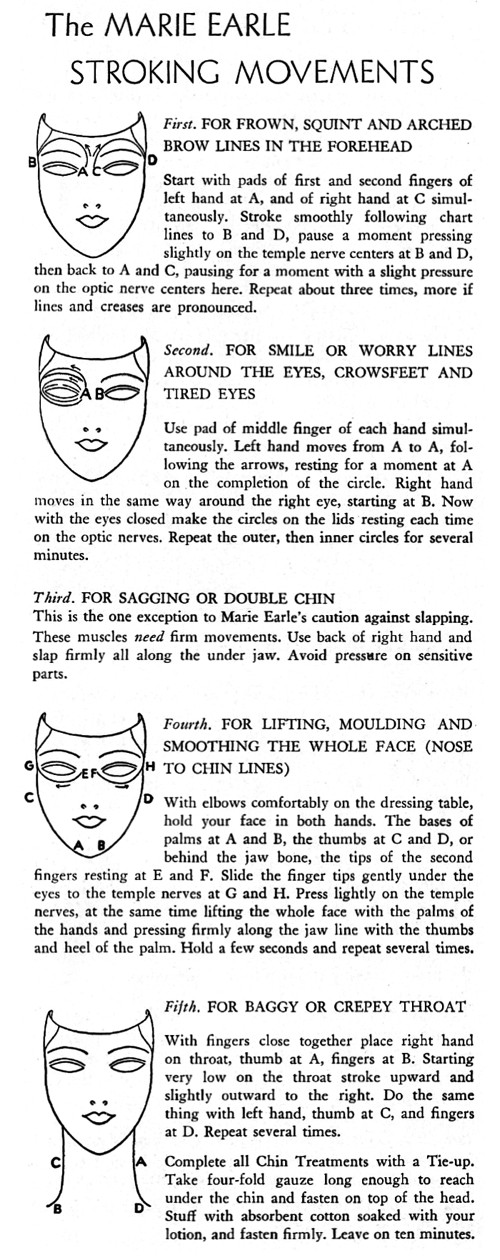
Above: 1933 Marie Earle stroking technique.
Basic treatment
Given the economy of the 1930s, Marie Earle considered it necessary to introduce a cut down skin-care routine. Requiring only three preparations – Essential Cream, Cucumber Emulsion and Eau Antirides – it was called the Basic Treatment and was expected to take only 10-minutes per day.
Marie Earle gives you a basic treatment that is amazingly simple as it is effective. It consists of just three preparations. Everyone works for you. Marie Earle’s Essential Cream enriches tired skin, returns velvety softness. You use it twice, once to cleanse, again to nourish. Over the second application you smooth Marie Earle’s cucumber Emulsion, to clarify and whiten. Finally Eau Antirides, to tone and refresh. The result? A glowing freshness that you may have thought you left behind you many birthdays past!
(Marie Earle, 1935)
Make-up
As with skin-care, Coty did not alter the Marie Earle make-up routine in any major way. Women could elect to use Finishing Cream (Blanc Gras), as a foundation (Shades: White, Rachel, Chair, Ochre, and Sunburn) as or use Foundation Cream if they wanted to avoid using colour. This could be followed by Paste Rouge (Shades: Extra Light, Light, Dark, and Raspberry), after which the face would be powdered (Shades: Chair, Peach, Rachel, Ochre, Sunburn, Blanche, and Soleil) before eye make-up and lipstick (Shades: Light, Medium, Dark, and Vivid) were applied. Liquid Powder could be used on the neck and at night on the shoulders, arms and hands, although Marie Earle recommended Eau Mysterious instead of Liquid Powder if the skin was oily or the weather hot enough to cause perspiration.
Colour coordination schemes developed by Marie Earle were based around hair colour and were given for Blonde, Titian, Light Brunette, Dark Brunette, and Gray hair. Three examples are listed below:
Blonde Light Brunette Dark Brunette Finishing Cream Chair Rachel Sunburn Liquid Powder Chair Rachel Sunburn Paste Rouge Light Raspberry Dark Lipstick Vivid Vivid Dark Eye Shadow Blue Gray Green Eye Crayon Chatain Brun Noir Face Powder Peach Rachel Sunburn Mascara Chatain Brun Noir (Marie Earle, 1933)
The different make-up colour schemes were promoted using deco-inspired mannequins. Photographs of these were used widely in advertising of the period while the actual models were presumably used by demonstrators as a ready reference for customers.
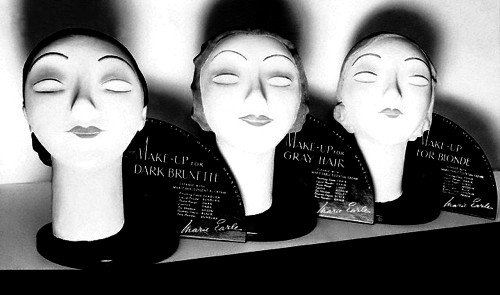
Above: 1931 Marie Earle mannequins demonstrating make-up that tones with dark brunette, gray and blonde hair.
Also see the company booklet: Understanding Your Skin
1940s and beyond
Like other companies in the United States, Marie Earle was affected by the Food, Drug and Cosmetics Act (FD&CA) of 1938. The legislation put an end to the use of terms like ‘skin foods’ and ‘muscle oils’ in the United States, which made null and void most of the explanations used by Marie Earle to explain its product effectiveness. Then, in 1940, the fall of France cut the French company off from the American arm. I have be unable to find any reference to Marie Earle in France after the war so the hostilities may have resulted in the end of the business there.
Things were better for Marie Earle in the United States. New products were released during and after the war including: Essential Foundation (1942), a creamy make-up in Rachel, Naturelle, Suntan, Cinnamon, and Tropicolor shades; Peach Satin Cream (1947), a neck and chest cream; Aralinn (1948), a skin lotion; Masque Glace (1952), a foundation cream; and Aralinn Foundation (1952), a liquid cream.
Aralinn: “a revolutionary lotion, combines astringents and fine oils, stimulates circulation, but never dries the skin.”
General Beauty Products
In 1954, Coty combined Marie Earle, Lilly Daché cosmetics and Lucien Lelong into a new company, General Beauty Products, Inc. with Lilly Daché [1893-1990] as its president. Lilly Daché, a well-known hat designer, had a connection with Coty through her 1931 marriage to Jean Despres [1903-1988], then an executive vice-president of Coty. Daché was well known to Americans and her name was used to promote Marie Earle during the 1950s. Marie Earle products from the period often carried the phrase ‘Created by Lilly Daché for Marie Earle’ and even Marie Earle Essential Cream became ‘Marie Earle Essential Cream by Lilly Daché’. All in all, this signals a brand decline.
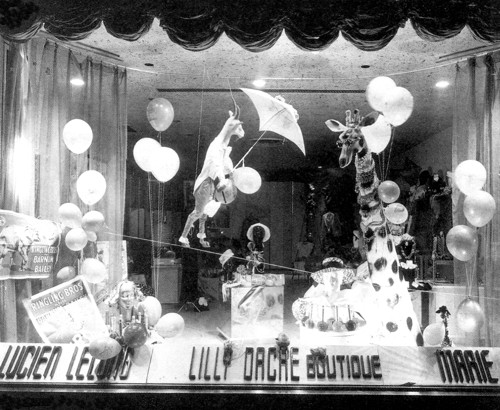
Above: Lilly Daché salon in the Plaza Hotel, New York in the 1950s. Reference to Lucien LeLong and Marie Earle can be seen on the window frame.
Daché made frequent trips to Paris and attempted to revive the Marie Earle line by introducing new skin-care products currently in vogue there. In 1954, Marie Earle became one of the first companies to introduce royal jelly cosmetics into the United States,starting with Queen Bee Cream (1954), followed by Queen Bee Masque, and Queen Bee Emulsion. Unfortunately, the company did not capitalise on the royal jelly fad as well as other entrants. Its products were largely aimed at the cheaper end of the cosmetic market and its advertising budgets were tight.
See also: Royal Jelly
Lilly Daché also released Skin Vitamins, a box containing a month’s supply of vitamins packaged in 32 individual vials – one to be used each day to ‘treat dry, flaky, sensitive skin’ – an application style very reminiscent of French serums.
Sale
Coty’s financial position worsened during the 1950s, mainly due to the increased costs associated with advertising on television. Coty lost money in 1957 and 1958 and this seems to have triggered the offloading of some of its subsidiaries including the sale of Lilly Daché, Lucien Lelong and Marie Earle to Mary Chess in 1960. The divestments did not keep Coty independant and it was bought by Chas. Pfizer & Co. in 1963.
See also: Coty
The 1960s and 1970s saw a good deal of change in the American cosmetic market and Marie Earle went through a series of owners including Nestle-LeMur (1964) and the Hichens Chemical Company (1970) before it disappeared. It has recently been resurrected but I have been unable to identify the new owners.
Timeline
| 1909 | Marie Earle salon opens at 279 Rue Saint-Honoré, Paris. |
| 1910 | Marie Earle company established in Paris. |
| 1912 | Marie Earle branch opened at 30 East 57th Street, New York. |
| 1918 | First American Marie Earle salon established in New York. |
| n.d. | Paris salon moved to 23 Rue Pasquier. |
| n.d. | New York salon moves to 600 Madison Avenue. |
| 1922 | Marie Earle, Inc., organised in New York. |
| n.d. | Salon opens in Beacon Street, Boston. |
| 1926 | New York salon moves to larger quarters at 659 Fifth Avenue. |
| 1927 | Salon opens in Los Angeles. New York salon moves to 660 Fifth Avenue. |
| 1928 | Salon opens in Southampton, Long Island. Marie Earle bought by Coty. |
| 1929 | Marie Earle product line repackaged. |
| 1929 | New Paris salon opens at 15 Rue de la Paix. |
| 1932 | New York salon moves to 714 Fifth Avenue. Smaller sized preparations introduced. New Products: Hand Lotion, Eye Wash and Eye Cream. |
| 1934 | Marie Earle product line repackaged. New Products: Nurimor dry skin cream. |
| 1935 | New Products: Astringent Throat Cream. |
| 1942 | New Products: Essential Foundation. |
| 1943 | New Products: Perfection Leg Make-up. |
| 1946 | New Products: Golden Morn, a dry skin cream. |
| 1947 | New Products: Peach Satin Cream, a neck and chest cream. |
| 1948 | New Products: Aralinn, a skin lotion. |
| 1952 | New Products: Masque Glace, a make-up foundation cream; Aralinn Foundation, a liquid cream; and Aralinn Home Treatment Package. |
| 1954 | Coty creates General Beauty Products, Inc. containing Lucien Lelong, Marie Earle and Lilly Daché Hair Cosmetics. Marie Earle moves to 78 East 56th Street, New York. New Products: Queen Bee Cream. |
| 1957 | New Products: Queen Bee Hand and Body Lotion. |
| 1960 | Lucien Lelong, Marie Earle and Lilly Daché sold to Mary Chess. |
| 1964 | Nestle-LeMur buys Lucien Lelong, Marie Earle and Seaforth from Mary Chess. |
| 1970 | Hichens Chemical Company acquires Marie Earle. |
First Posted: 22nd June 2015
Last Update: 30th July 2022
Sources
deNavarre, M. G. (1941). The chemistry and manufacture of cosmetics. Boston: D. Van Nostrand Company.
Marie Earle. (n.d.). Culture rationnelle et scientifique de la beauté par Marie Earle. Paris: Author.
Marie Earle. (1933). Understanding your skin. The essential key to personal loveliness [Booklet]. New York: Author.
Jones, G. (2010). Beauty imagined: A history of the global beauty industry. Oxford: Oxford University Press.
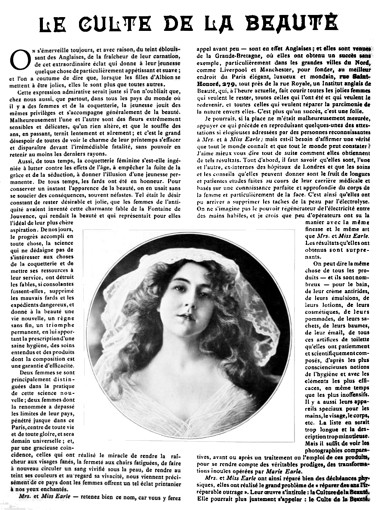
1909 Marie Earle advertorial from the French magazine ‘Les Modes’. I have often wondered if the woman in the photograph was Juanita Ebbsmith.
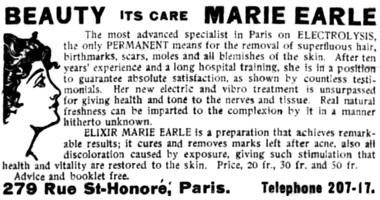
1909 Marie Earle advertising electrolysis and other treatments available for Americans visiting Paris.
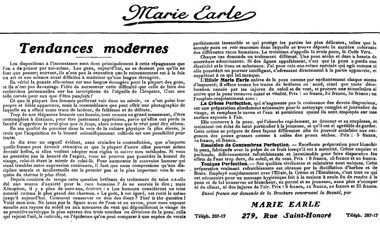
1910 L’Elixir Marie Earle, La crème Perfection, Emulsion de Concombres Perfection and Tonique Perfection.
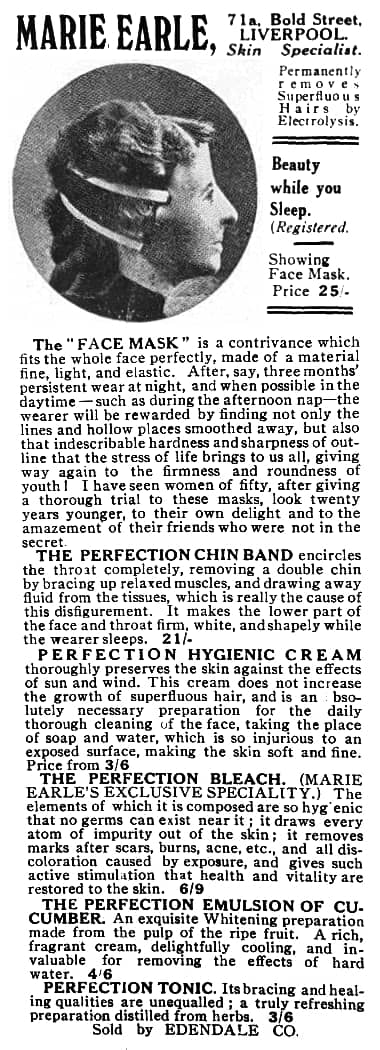
1911 Marie Earle.

1912 Marie Earle. The company is now listed at 30 East 57th Street, New York.

1922 How Marie Earle Preparations Came to America. The trademarked Marie Earle signature on the bottom of this advertisement was penned by Juanita Ebbsmith.
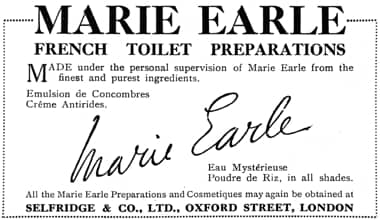
1922 Marie Earle (Britain).
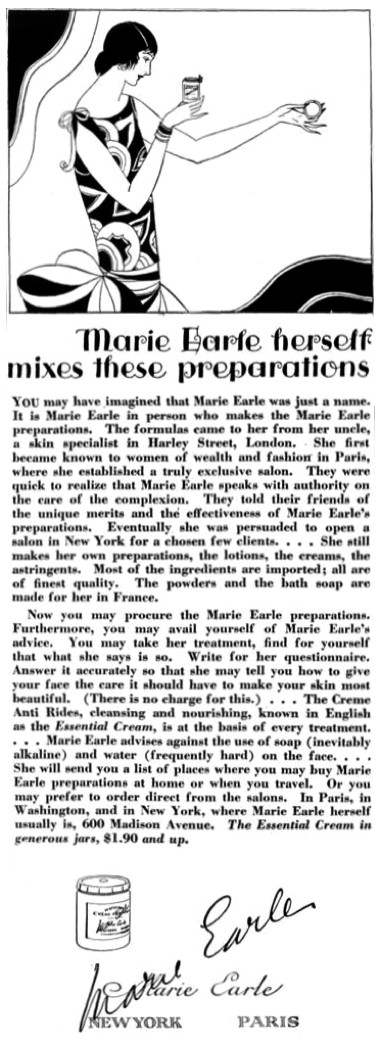
1924 Marie Earle.

1925 Marie Earle.

1926 Marie Earle salon at 659 Fifth Avenue, New York.
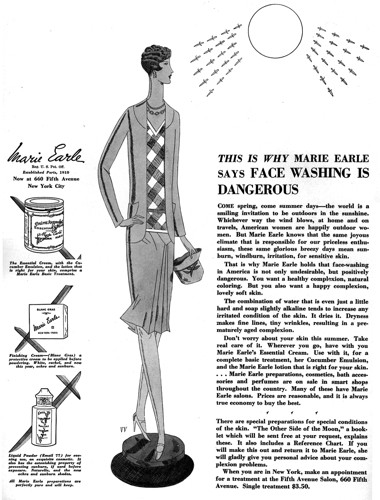
1928 Marie Earle. Face washing is dangerous.
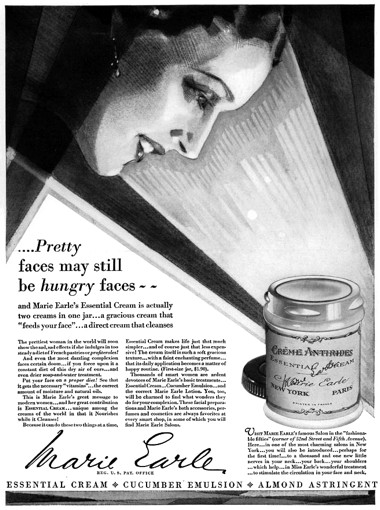
1928 Marie Earle Essential Cream.
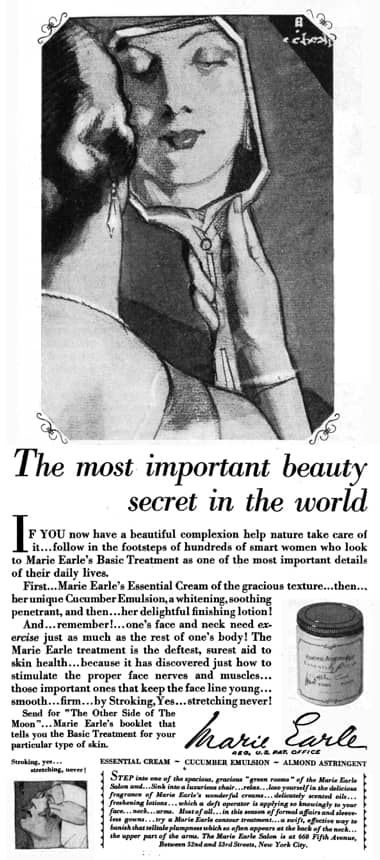
1928 Marie Earle Essential Cream.
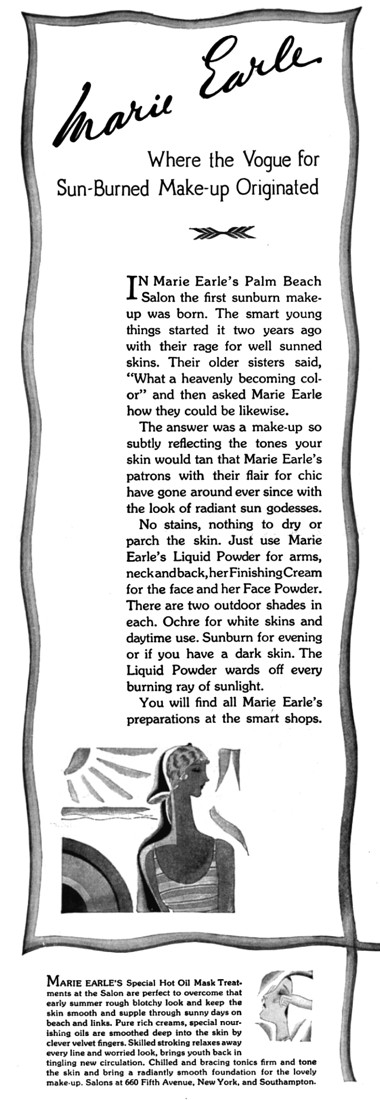
1929 Marie Earle Hot Oil Mask Treatment.
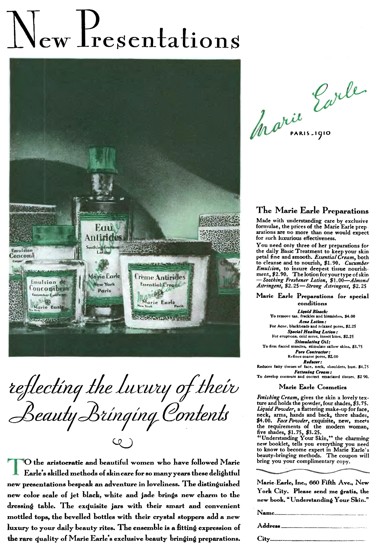
1929 Marie Earle in new packaging introduced in 1928.
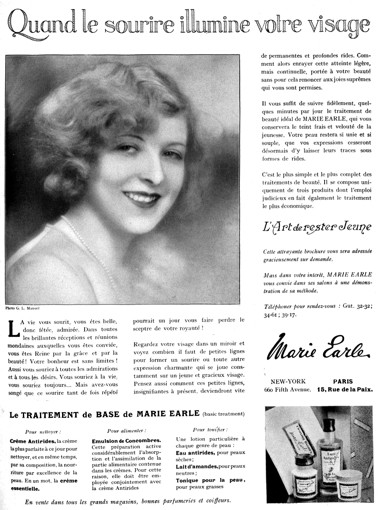
1930 Marie Earle.
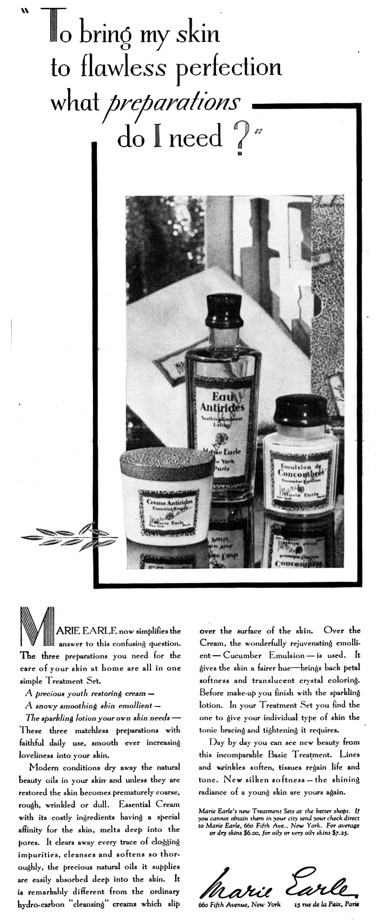
1930 Marie Earle.
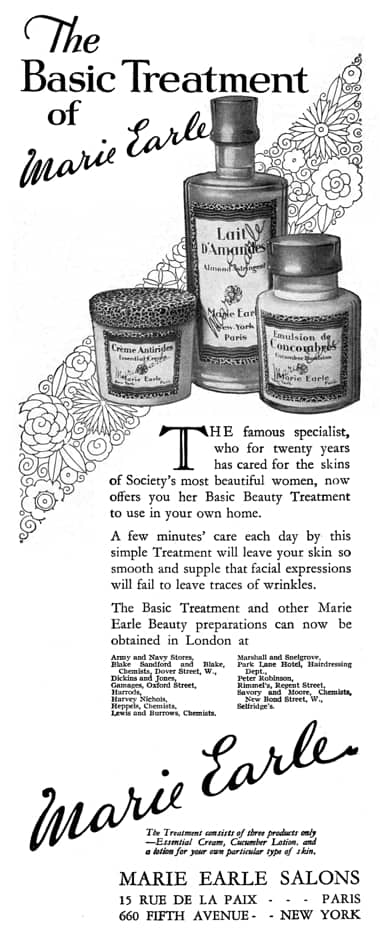
1930 Marie Earle (Britain).

1931 Marie Earle skin care and make-up for a brunette with average skin.
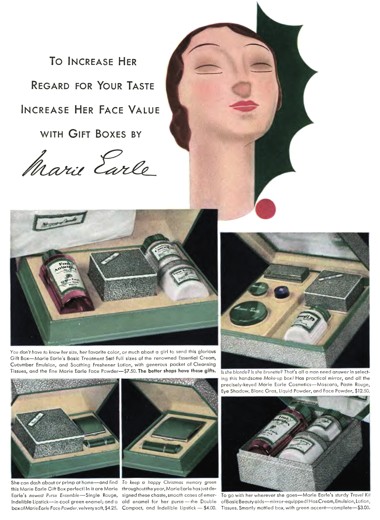
1932 Marie Earle Christmas gift boxes.
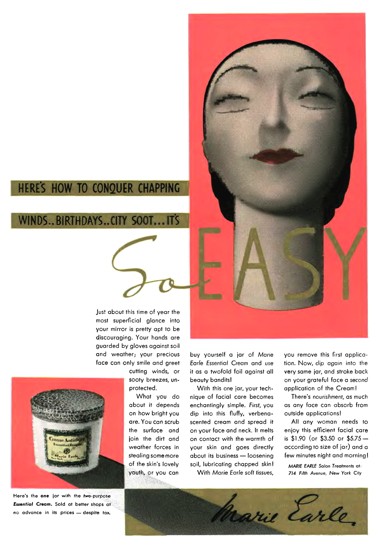
1933 Marie Earle.
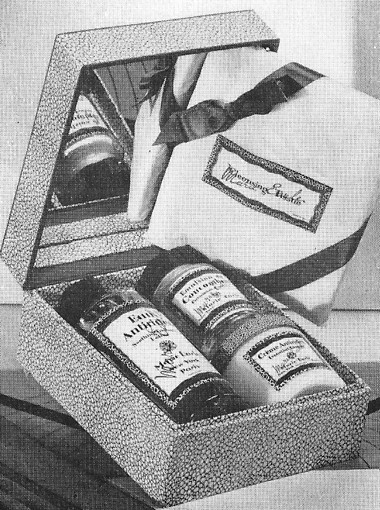
1933 Marie Earle Crème Antirides (Essential Cream), Emulsion de Conconbres (Cucumber Emulsion) and Eau Antirides (Soothing Freshener Lotion).
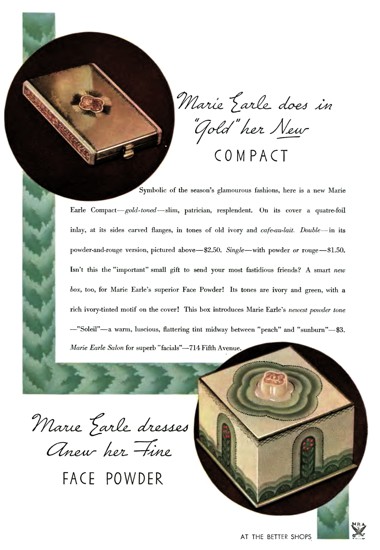
1933 Marie Earle Compact and Face Powder.
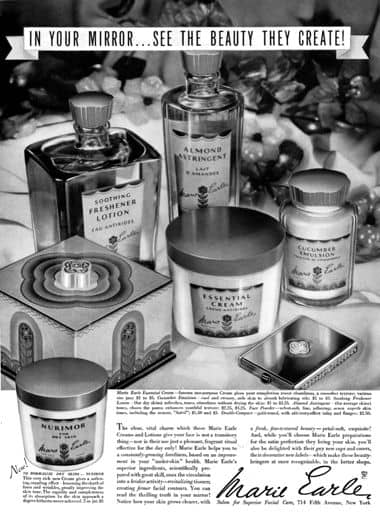
1934 Marie Earle cosmetics.

1937 Marie Earle Essential Cream, Cucumber Emulsion and Eau Antirides. These three preparations made up the 10-minute Marie Earle Basic Treatment.
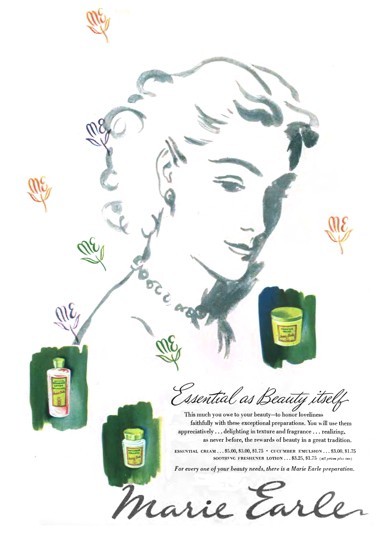
1946 Marie Earle.
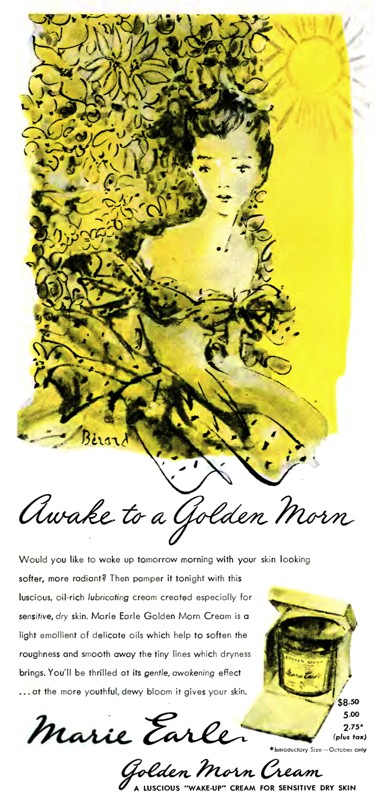
1947 Marie Earle Golden Morn Cream. The product was released in 1946 but was repackaged in a new gold-plated jar in 1947.
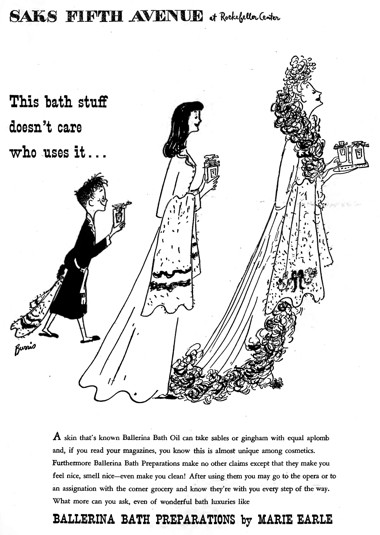
1947 Marie Earle Ballerina Bath Preparations. Based on the Ballerina fragrance (1940) these included a Toilet Water, Bath Oil, Bath Salts and Talc along with a Sachet Pillow, Sachet Powder and Bath Mitt Set.
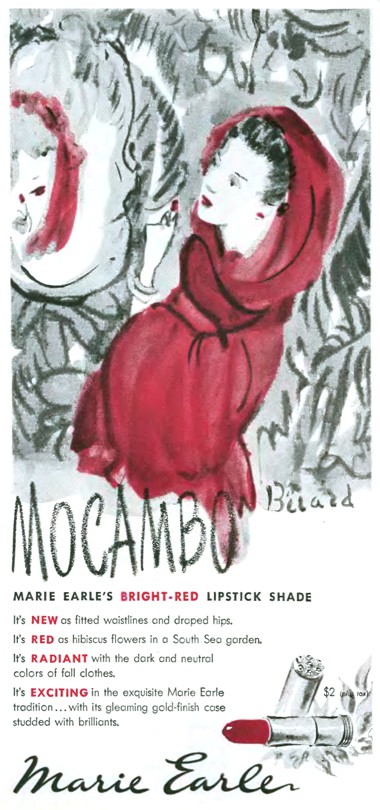
1947 Marie Earle Mocambo Lipstick.
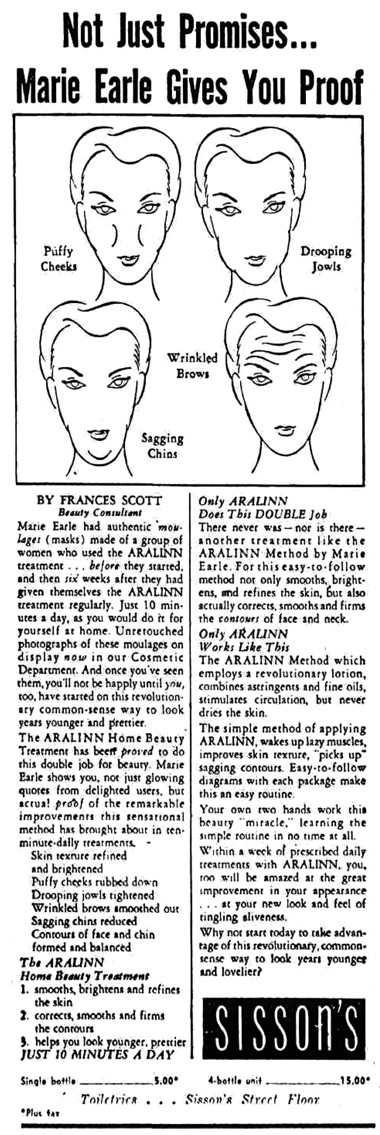
1952 Marie Earle Aralinn Lotion.
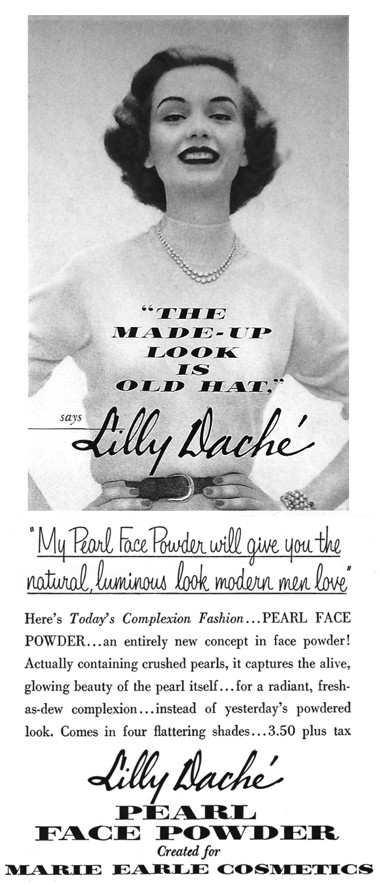
1957 Marie Earle. Lilly Daché is more prominent than Marie Earle.
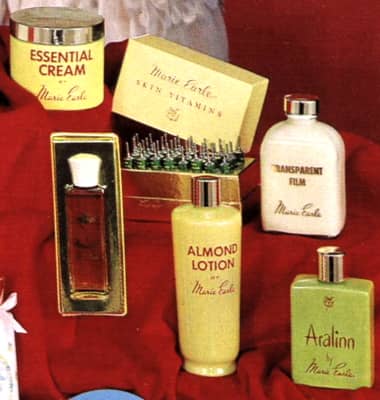
1964 Marie Earle. Some of the products now owned by Nestle-LeMur.
